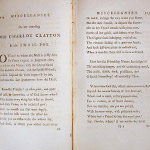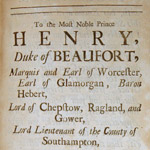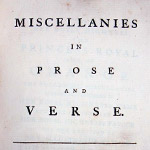Cabinet 09: Women Writers
Mary Jones, Miscellanies in Prose and Verse. Oxford: Printed, and delivered by Mr Dodsley, and 2 others, 1750. Deb Eb 1750 J
'The following pieces, the produce of pure nature only, and most of them wrote at a very early age…'. So begins Mary Jones's advertisement to her own Miscellanies in Prose and Verse (1750), her only literary work. Jones (1707-1778) was friends with Martha Lovelace, who later married Lord Henry Beauclerk, and Charlotte Clayton, the future Lady Sundon. Her promotional efforts obviously paid off, because there are a staggering 1400 subscribers listed in this work, including Horace Walpole and William Blackstone. Dr Johnson named her 'the Chantress', and Thomas Warton called her 'a most sensible, agreeable and amiable woman.'
Ann Radcliffe, The Mysteries of Udolpho. London: Printed for G. G. and J. Robinson, 1794. DeB Eb 1794 R
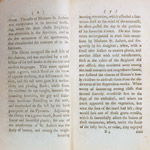 |
 |
Ann Radcliffe (1764-1823) received £500 for her fourth novel, The Mysteries of Udolpho (1794). This 'moral romance', as she called it, with its mix of the supernatural, the mysterious, the sentimental, and the inevitable gloomy castle, was a success. It certainly raised the profile and reception of the Gothic novel. By the time Radcliffe died in 1823, she was hailed as the 'great enchantress.' This position of acclaim was extraordinary considering that Radcliffe only started writing as a means of amusing herself during the long evenings when her husband William was away reporting Parliament. This first edition of The Mysteries of Udolpho was purchased last year by endowment funds gifted by Dr Esmond de Beer, the authority on John Evelyn and John Locke. |
Frances Burney, Camilla: Or, A Picture of Youth. London: Printed for T. Payne, and 2 others, 1796. DeB Eb 1796 B
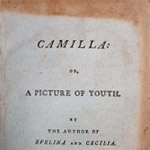 |
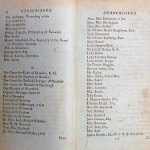 |
Through her father, Dr Charles Burney, Frances (Fanny) Burney (1752-1840) came to know Sir Joshua Reynolds, the memoirist Hester Thrale (later Piozzi), Samuel Johnson, and Edmund Burke. Just after her marriage to Alexandre-Jean-Baptiste P. D'Arblay, a Catholic soldier, she began Camilla, or, A Picture of Youth, which eventually appeared on 28 June 1796. For Evelina (1778), her first work, she was paid 20 guineas. In order to obtain greater profits from Camilla, Burney instigated a vigorous subscription campaign which resulted in 300 subscribers paying a guinea and a half for it. The subscribers included Burke (who took 15), Elizabeth Montagu (10), Hester Thrale, Anne Radcliffe, Hannah More, Maria Edgeworth, and from the entries displayed, Sir Joseph Banks, and Jane Austen, then an unknown twenty-year-old. |
